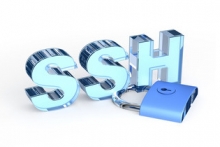SSH (Secure Shell) is a cryptographic network protocol that provides secure services over insecure networks. Its best-known field of application is secure login to remote computers. The protocol uses public key authentication to create and maintain the secure channel through which commands can be issued on the remote computer, files can be copied between the two computers using SFTP (Secure FTP) is SCP (Secure Copy) protocols, or even X11 connections can be transmitted using the tunneling function. Thus, SSH can be considered as a kind of security standard through which several other protocols can communicate encrypted. By default, SSH servers monitor the 22 TCP port.
SSH's primary purpose is the previous one telnet and the insecure remote shell was the replacement of protocols such as rlogin, rsh, rexec, which did not provide security against channel eavesdropping as they even transmitted passwords between the parties in plain text. The first version of the protocol (now known as SSH-1) was designed in 1995 by Tatu Ylönen, a researcher at Helsinki University of Technology. The freeware implementation became very popular due to its efficiency, by the end of 1995 it had been used by tens of thousands.
Basically, this encryption protocol was created to log on to remote computers and run remote commands, and any network service can be encrypted using SSH, so it has a very wide range of applications. The protocol specification distinguishes between two main versions: SSH-1 and SSH-2.
SSH authenticates the remote computer with public key encryption and authenticates the user if necessary. There are several ways to use the system: One way is to use automatically generated public and private key pairs to encrypt your network connection, and then use password authentication to log on. The other way is to use a manually created public-private key pair to perform authentication, which allows users or programs to without having to enter a password. In this method, anyone can create key pairs and place the public key on a computer where the owner of the uploaded public key pair (private key) can enter the computer.
Authentication is based on the private key, but the private key is never passed over the network. SSH only verifies that the same person who offers the public key also has the appropriate private key.
Common SSH clients for Windows
Related Content:
- Manual Page - ssh
- CLI
- The command line
- Shell (Unix shell)
- Bash (Bourne Again Shell)
- SSH login without password using public key
- How to handle "WARNING: POSSIBLE DNS SPOOFING DETECTED!" and "REMOTE HOST IDENTIFICATION HAS CHANGED!" error at ssh login time?
- How to access SSH (SFTP) file systems on remote Linux servers from a Windows computer
- 358 views

